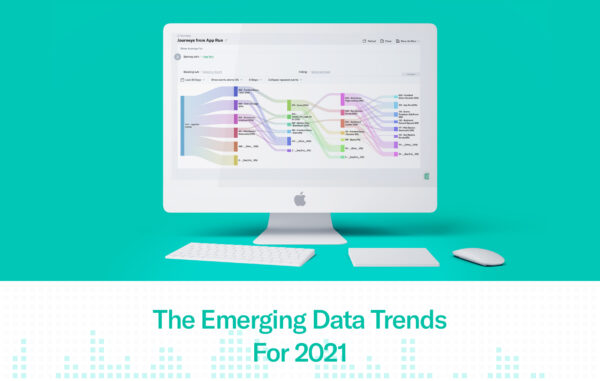Today’s businesses produce and collect more data than ever—data that continues to grow with each passing day.
In other words: data isn’t a competitive advantage anymore. Insights are.
The challenge for companies in 2021 and beyond is to assemble a modern data stack that enables them to process data more quickly and efficiently, to speed up time to insight and make better, data-driven decisions faster.
New technologies (and tech buzzwords) are developing fast to meet that need.
Which of those data technologies will make a big splash? Here are the top 5 emerging data trends for 2021 as we see them.
Cloud Data Warehouses
Over the last several years, cloud computing has gone from expensive and technical to affordable and accessible for every organization, regardless of size or budget. With the democratization of the cloud, companies have unparalleled access to real-time data they can use to drive everyday decision-making across the organization.
Better access to real-time data means:
- Expanding use cases across the org
- Faster time to insight
- Increasing integration of data into day-to-day decision-making
Cloud data warehouses (CDWs) are poised to continue to grow rapidly and emerge as the gravity well for all that company data.
Modern data warehouses are self-service, easy to implement, and ready to serve as a central source of truth—compiling all company data into one place that can quickly connect with a wide variety of downstream analytics tools.
In our view, that’s a huge positive shift, enabling companies to:
- Power new use cases and scale data usage indefinitely
- Democratize access throughout the organization, making it easy for even non-technical teams to integrate data into their day-to-day
- Perform increasingly powerful, accurate, and optimized real-time analysis that powers decision-making and leads to better products and more revenue
- Increase autonomy for data users, increasing time to insight, lessening the burden on data analysts, and freeing up data teams to focus on bigger picture issues
As the gravity well, data warehouses enable companies to see a holistic picture of their customer data. Because of that, they sit at the heart of the modern data infrastructure.
A whole ecosystem of tools has sprung up around cloud data warehouses because of that, enabling businesses to:
- Easily aggregate data from multiple sources into a single repository
- Operationalize customer data
- Enable everyone in the organization, regardless of skill set, to leverage, access, and operationalize this data
Further Augmented Data Management
Augmented data management (ADM) combines Artificial Intelligence and Machine Learning capabilities to allow information management categories to become self-configuring, self-tuning and self-sufficient.
By automating a variety of manual tasks, ADM allows users of any technical skill level to use data more autonomously.
But with all the data businesses produce these days, it isn’t easy to manage. Cloud data warehouses help with this, along with:
- Improving and increasing metadata
- Great use of Augmented Data Quality (ADQ) tools
- Data catalogs
- Increased reliance on Semantic Knowledge Graphs
- Data fabric technology
Data fabric is a unified architecture of technology that uses the Internet of Things (IoT) to simplify and integrate data management processes across sources. These will play a key role throughout 2021 in helping to expand the capabilities of ADM.
With a data fabric, companies enjoy:
- Wider availability of data
- Fewer data silos
- Increased opportunity for automation
- Greater data governance and control
Scalable AI
Standard Artificial Intelligence (AI) refers to the programming of machines to simulate human intelligence, allowing them to learn and problem-solve without needing human help.
AI has been a buzzword for years, but in 2021, it’s all about scalable AI. Traditional AI is powerful, but it gets slower and less reliable as you add more data and complexity.
Scalable AI is the solution to that. It’s AI that can grow with your data, handling ever-expanding datasets, workloads, and processes. Scalable AI is fast, accurate, and efficient no matter how your data and AI needs grow.
With an AI solution that can scale, companies can:
- Accelerate and improve data processing
- Get more insights and predictions
- Better navigate complex business scenarios with AI
Take financial companies, for example—many use AI to flag transactions that may be fraudulent. With companies like Worldpay and Mastercard processing millions of transactions a day, they need scalable AI that can make sense of all the data and spot suspicious transactions in less than a minute, before the transaction gets manually approved.
Traditional AI tools just aren’t fast enough at that level of scale, and that’s why scalable AI is set to take off in 2021.
Edge Analytics
Edge Analytics refers to a distributed model for data analysis aimed at speeding up the operationalizing of data by analyzing incoming data at a non-central place within the system. Edge computing environments allow for the processing of this data.
Data is still transferred to the warehouse or other central repository—but it’s analyzed and put to work right at the source. That means users can get real-time insights, without waiting for processing and storage to take place.
That offers a number of benefits for companies using Edge Analytics and computing:
- Greater data governance
- Speedier data processing
- Increase in real-time value
The speed of Edge Analytics allows for bona fide real-time event analytics that aren’t beholden to the time it takes for data to move back to a central server, be processed, and then piped into the analytics system.
That speed makes other technologies like IoT and service intelligence (among others) faster, expanding usage and use cases.
Augmented Customer
Technology isn’t the only thing growing increasingly augmented—your customers are, too.
- Voice-based AI assistants like Siri and Alexa
- Smartphones
- Smart homes
- Wearable tech
The same technology powering today’s top companies is increasingly available to regular consumers.
As tech evolves for consumers—and collects more and more data on them—customer expectations will continue to grow.
Here’s the good news: digital transformation means companies have more insight than ever into the customer journey and experience. By analyzing that journey, you can:
- Build better experiences for your customers
- Increase customization and personalization
- Exceed customer expectations



